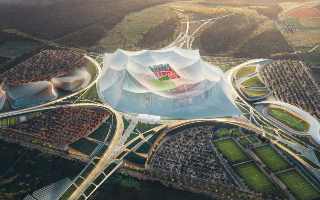Morocco: Renderings of the world's largest football stadium revealed
source: StadiumDB.com; author: Jakub Ducki
 The 115,000-capacity football stadium, located in the heart of Morocco, is set to become the largest of its kind in the world. Grand Stade Hassan II, designed by Populous in collaboration with Parisian architects, promises to be an impressive project. What will this new stadium giant offer us?
The 115,000-capacity football stadium, located in the heart of Morocco, is set to become the largest of its kind in the world. Grand Stade Hassan II, designed by Populous in collaboration with Parisian architects, promises to be an impressive project. What will this new stadium giant offer us?
Advertisement
A design in keeping with Moroccan tradition
The design of Grand Stade Hassan II draws deep inspiration from Moroccan culture, in particular the traditional social gatherings known as moussem.
The main design inspirations also include the tent, the garden and the Moroccan landscape. The centrepiece of the structure is an imposing tent-shaped roof that seems to grow out of the surrounding landscape, blending harmoniously into the wooded surroundings. The stadium is intended not only to impress with its form, but also to act as a cultural symbol, referencing Moroccan heritage.
The stadium is distinguished by its unusual architecture, where three steep, compact tiers of stands create a dynamic space, providing an unforgettable experience for spectators. Each of the two main stands can accommodate as many as 29,500 people, making them among the largest sectors in the football world. Along the sides of the pitch, five premium levels are planned, offering seating for 12,000 people, including VVIP users, VIPs, Hospitality zone guests, box holders and members of the Royal Family.
 © Populous
© Populous
New and innovative
Grand Stade Hassan II stands out not only for its gigantic capacity, but also for its unique architectural solutions. The stadium's roof, made of an aluminium truss with a unique geometry, gives the venue a futuristic look. The structure is supported by a ring of 32 stairs, which form monumental gateways leading into the stadium. These stairs also form the basis for the elevated platforms that house the lush gardens, which are as high as 28 metres above the ground.
The green spaces under the translucent roof create the impression of an oasis, a place of harmony between modernity and nature. It is also worth noting that the stadium will be surrounded by botanical gardens at ground level, which will emphasise theecological nature of the facility.
 © Populous
© Populous
Construction starts ever closer
The Grand Stade Hassan II will be fully FIFA-compliant, allowing it to host the finals of the 2030 FIFA World Cup, in which Morocco is expected to co-host with Spain and Portugal. Will the arena prove worthy of the final of the competition? We will find out. The stadium will also be home to two local clubs, Wydad AC and Raja CA.
Preparations for the start of construction work are already at an advanced stage. Following the approval of public funding in October 2023, groundworks are set to begin on a 100-hectare plot of land in El Mansouria, 38 km north of Casablanca. Renowned engineering firms such as Maffeis Engineering, ME Engineering and Rider Levett Bucknall are involved in supporting the project team to deliver this ambitious project.
 © Populous
© Populous
Symbol of modernity and tradition
Christopher Lee, Populous' managing director for EMEA, emphasises the importance of the project for Morocco and the entire football world: Grand Stade Hassan II will be a truly iconic, landmark venue for Morocco and for football itself, that will become one of the great stadia of the world.
For his part, Tarik Oualalou, lead designer and founding partner of Oualalou + Choi, points to the stadium's deep roots in Moroccan culture: The Grand Stade Hassan II is deeply rooted in Moroccan culture, with its traditions and contemporary expressions. Stadium is the embodiment of the great tradition of Moroccan hospitality.
François Clément, president of Populous France, added: The Grand Stade Hassan II will provide extraordinary spaces that create exceptional experiences for every fan and every visitor.
As well as rising to the heights of modern architecture, the stadium is a key part of King Mohammed VI's vision for the development of Moroccan sporting infrastructure.
Advertisement

 StadiumDB
StadiumDB